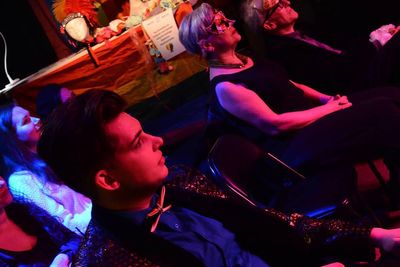It's probably not thought about widely by others outside of the trans musical community, but music composition and trans voices often conflict with each other. Think about it; you're changing your body to make you feel authentic to your gender, but your voice doesn't exactly follow.
Furthermore, if you are a singer, that can be devastating. You want to be able to express your authentic self both in body and voice. There is a lack of musical compositions that are trans-inclusive, so Aiden K. Feltkamp decided they would create an anthology of pieces that transgender folks could use, and it's quite a milestone concept.
Aiden explains in the interview below how and why it's important to have inclusivity in the musical world. There are many questions with complicated answers, but it's an eye-opening story about something you probably haven't thought of before.
Aiden K. Feltkamp
Aiden K. Feltkamp talks about trans voices and musical compositiion.
For people such as myself who need a basic explanation of this project; can you tell me what it is and why it’s important.
Of course! As an opera singer, you mostly learn and perform music from 50-400 years ago. However, there are composers creating opera and classical art songs today. In the field, we call this New Music.
This anthology collects New Music -- songs from operas, art songs, and musical theater songs that have been written by living composers -- that feature trans and nonbinary voices. To be eligible for the anthology, the song had to meet one of three criteria: either the music was written by a trans or nonbinary composer, the text was written by a trans or nonbinary writer, or the music was written for, and performed by, a trans or nonbinary singer.
As a trans nonbinary opera singer myself, I found it difficult to find repertoire that aligned with my gender experience. This anthology was, at first, a project to rectify that. Then, I realized that many voice teachers with trans or nonbinary singers, as well as presenters who wanted to diversify their programming, wanted a place to find repertoire for/by trans and nonbinary performers. This anthology fills all of those needs in our industry.
There isn't an existing anthology of vocal works for trans and nonbinary singers (believe me, I've tried to find one!). So this is the first. It's important for that reason, and for the others, I've explained above.
How are trans voices different and why would they need compositions in varied ranges that are not typical in traditional music?
Since trans people span the gamut of genders and ranges, the compositions must also. This is especially important because so much music written for women sits in the treble range, but feminine people can possibly have voices in the bass and treble ranges. The same goes for repertoire traditionally written for men.
What is voice Dysphoria?
In relation to trans and nonbinary people specifically, this is when your voice doesn't match your gender identity and therefore causes you gender dysphoria. Gender dysphoria is feeling discomfort or distress (to varying degrees) because your body differs in some way from your gender identity.
While most transmasculine people find their pre-HRT voice dysphoric, I didn't. Sometimes my speaking voice pre-HRT would cause people to misgender me as female and that would lead to gender dysphoria, but I didn't feel that my speaking or singing voice pre-HRT was at odds with my gender identity.
Tommy Venus
Sweets by Kate Stonewall
Despite my personal experience, this is a serious issue for many trans and nonbinary people and leads to a lot of gender dysphoria. This is the main reason that I'm working with the Musical Mentors Collaborative on GEMM club: a program that provides free voice lessons to underprivileged and unhoused trans and nonbinary people.
Kim Petras is a popular pop diva whose range doesn’t seem forced. In other words, it seems biological. Are pop music voices easier to manipulate because of technology as opposed to live music which requires more training?
Every voice is equally biological. If we're talking about technique, there are different vocal techniques for different genres of music. It could just be that Kim Petras' voice is naturally better suited to a pop style of singing. It's also possible she could learn to sing more classically if she wished. Production on pop songs can hide technical "flaws" (such as intonation issues or taking a breath where it's less than desirable) where live music cannot, but classical music can also be produced in a way to hide these things. Classical music tends to be more exposed, just as a facet of the genre, and the technique can be more complicated, but I don't think that one genre or style of singing is more forced than another.
Connecting to Songs as Your Authentic Self
What advice would you give a trans person who just sings casually with the radio or in the shower but suddenly feels self-conscious after transitioning?
Is there a psychological thing that happens, say to a trans female, when a past favorite song features a male lead singing about “male” things then suddenly that person transitions and they revisit that same song? I can only speak from my own experience here.
Aiden K. Feltkamp
Written by Aiden K. Feltkamp
NewMusicShelf Anthology of New Music: Trans & Nonbinary Voices, Vol. 1 is available on Amazon, BarnesandNoble.com and wherever books are sold. Visit https://newmusicshelf.com.
